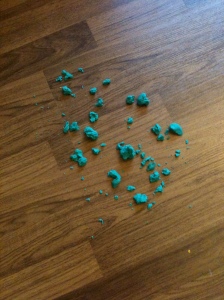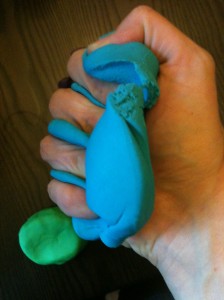A couple of days ago, Cate asked if she could play with play dough. No problem. It’s a great tactile toy and a wonderful way to keep kids entertained. Yes, it does make a bit of a mess, but unlike plasticine, play dough will dry into little solid bits and you can vacuum it up.
We’ve had our play dough for a few years and it has been getting a little worn out. I knew I needed to seriously address the issue when only two out of about twelve pots of play dough could be squished easily through a mold.
If you look online for advice on rehydrating play dough, including the official Play-Doh website, you generally get two pieces of advice: 1. Wrap the stuff in a damp paper towel and leave it overnight and 2. Add water, one drop at a time.
I had tried the damp paper towel trick, which was moderately successful, except that I forgot about the paper towel and had to pick out bits of dried paper towel from the play-dough the next time the kids played with it. I then tried the “add one drop of water at a time” trick, which worked pretty well. However, the next day the play dough was still kind of dried out. You could tell that the water hadn’t really incorporated into the whole lump of play dough.
All except one container. This was the container that had been in total bits and pieces and the only way I could put it together was to soak it in water and squish the bits together. This batch was almost as good as new.
Then the penny dropped. The secret to REALLY reconstituting play dough is increasing the SURFACE AREA that comes in contact with the water! So here’s the process.
- Use one of the “official” methods to get the play dough soft enough that it can fit through the “spaghetti-maker” extruder-bit. You know what I’m talking about.
- Make play dough spaghetti. Like this:
Alternatively, you can give the semi-dried out play dough to your one and a half year old to tear into bits and throw on the floor. Gather up the bits and ta-daaa, separated play dough with lots of surface area.
3. Pick up the spaghettied (or disembowelled) playdough in your hand and hold it under a running faucet for a couple of seconds. None of this pansy “one drop at a time” business. (By the way, this is a really good time to combine similar colours of play dough. We had 12 half-full pots of play dough and I was able to reduce that to about 7 full containers.)
4. Shake off the excess water and then squish the wet play dough in your hand. Start kneading.
It’s going to look nasty.
Told you so. Ignore it and keep kneading. It will get better.
See? Not quite as scary.
Almost there… (quick, name the movie reference!)
Well, look at that! See how the play dough absorbed all of the water?
5. Test your rehydrated play dough for squishyness.
There it is, all nice and pretty.
Poke.
Squiiiiish.
Ta-daa! The play dough has been successfully rehydrated. And it’s still going strong. Last tip – after I did this I found that my hands were pretty dried out, so make sure you moisturize or the feeling will probably drive you crazy. Oh, and if you try this at home, let me know how it turns out!












Thanks for tip. Worked a treat.
Fantastic! I’m glad it worked for you – our play dough is still going strong, although after yesterday’s extended play session, the purple may need some help!
Love it!
Thanks, I just tried this after a playdough session, and it worked great. Looking forward to nice, soft dough next time we haul it out. 🙂
I just did it and it worked! It made me wish I hadn’t thrown out all those dried out colors the last time we got the play doh out.
Glad it worked for you! My rehydrated playdough is still going strong, so it should probably last you a while longer!
I know you posted this a long time ago, but I searched “how to rehydrate my play doh” and this popped up! Worked great! Thanks!
Yeah, as you can see it has been a while since I posted! But I’m glad it worked for you, my play doh is still good too!
Thanks! Worked great.
So…. Star Wars?
Yep, Star Wars, you got it!
Thank you very much for this handy PlayDoh-ressurection trick! 😀
A hundred years from now, people will read your blog post and still find it extremely useful! 😉
See ya and happy Play Doh squishing! 🙂
I dribble a bit of water in the pot and leave the dough over night then mush it together the next day. Usually works pretty good!
I just tried it and it worked GREAT! My daughter was thrilled that we didn’t have to throw out her favorite color playdough!
Thank you! You’ve made my daughter happy again! Not only does it work great, it’s quick, and the mess was actually a little fun for me. (don’t tell anyone) 🙂
I know this is late reply, but I’m so glad it worked! And yeah, making a mess can be pretty satisfying…
Worked great! Thanks! I overdrenched the bits and a lot of the stuff went down the drain or stuck to my hands as mush. But I trusted the method and kept kneading. Gradually the mush left my hands and clumped into, what as far as I could tell, was newly bought playdoh!
Worked great! Being aggressive with the amount of water seems to be key…a few drops for a dried out hunk just isn’t enough.
That’s what I found, too – you could pretty much hold it under the tap and it would turn out fine. I”m not sure what Play-Doh is thinking with this “drop by drop” nonsense…